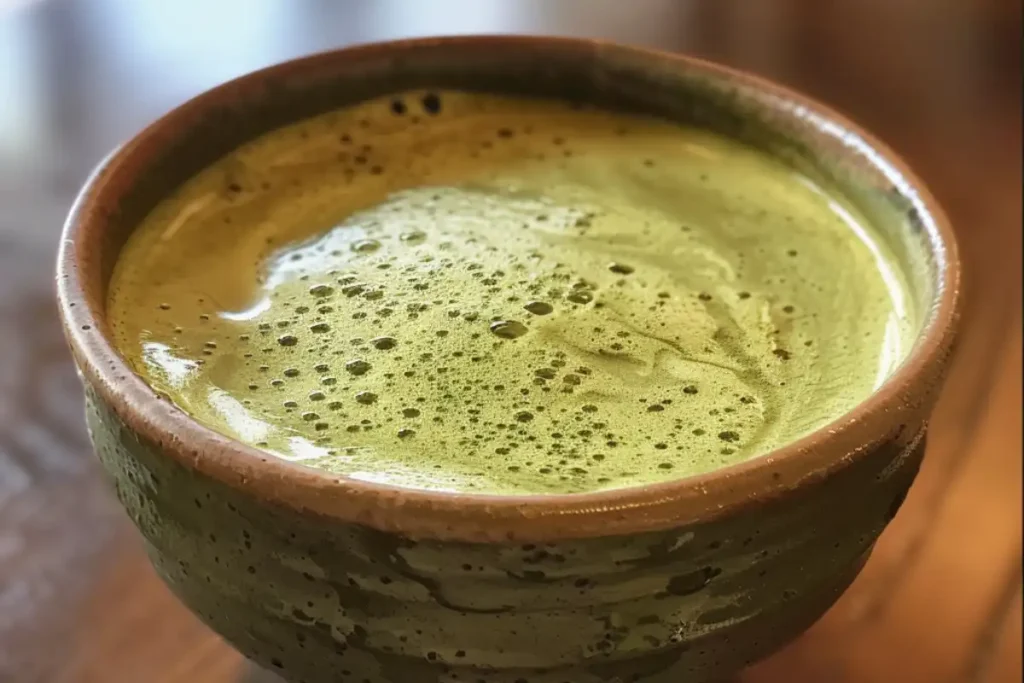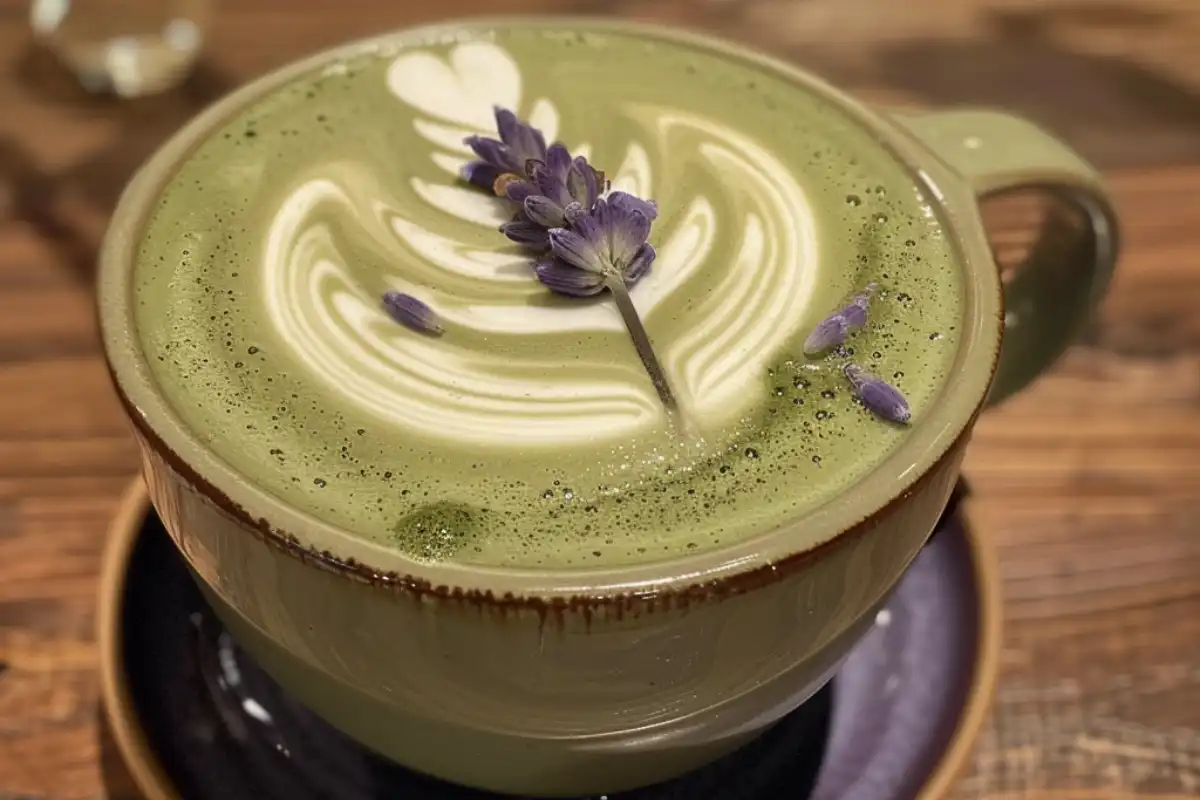The rising trend of combining matcha with lavender in beverages and desserts has piqued the interest of tea lovers and culinary adventurers alike. Matcha, a finely powdered green tea, offers an earthy and robust flavor, while lavender, a sweet floral herb, adds a calming, aromatic element to any dish or drink. The pairing of these two ingredients might seem unusual at first, but together they create a unique sensory experience. So, is matcha with lavender good? In this article, we’ll explore their complementary flavors, how to make popular matcha lavender drinks, creative uses beyond drinks, and much more.
What is Matcha?
Matcha is a type of green tea that has been ground into a fine powder. Unlike traditional tea where the leaves are steeped in water and then removed, matcha involves consuming the entire tea leaf, providing a richer and more intense flavor. Matcha has a long history, originating in Japan and often being used in tea ceremonies. Over the last decade, matcha has gained international fame and is used in a variety of ways—from traditional tea to modern-day lattes, smoothies, and even baked goods.
Key Features of Matcha:
- Rich, earthy flavor: The taste of matcha is distinctly earthy, slightly bitter, and savory, with a hint of sweetness. Some may find its flavor too intense, but it pairs well with other ingredients like milk, honey, and floral flavors such as lavender.
- Bright green color: The vibrant green color of matcha comes from chlorophyll, a pigment in the tea leaves that increases as they are grown in the shade before harvesting.
- Versatile in cooking: Matcha is not just for tea—it’s often used in lattes, desserts, smoothies, and even savory dishes like matcha noodles.

For more details on matcha and its traditional uses, explore this comprehensive guide to matcha.
What is Lavender?
Lavender, on the other hand, is a flowering herb known for its aromatic scent and soothing properties. While it is perhaps best known for its use in aromatherapy, lavender has also found its way into culinary applications, particularly in teas, syrups, and desserts. The floral sweetness of lavender adds a unique flavor that pairs well with both sweet and savory dishes.
Key Features of Lavender:
- Floral aroma: Lavender’s most distinctive feature is its sweet, floral scent. When added to food and drinks, it imparts a mild sweetness and a delicate fragrance.
- Calming and soothing properties: Lavender is often used in essential oils and teas to promote relaxation, reduce stress, and aid sleep. This calming nature makes it an excellent companion to matcha, which can sometimes have a stimulating effect.
- Culinary applications: Lavender is used in a variety of culinary creations, from lavender-infused syrups and jams to baked goods, cocktails, and teas.
Lavender, when combined with matcha, enhances the flavor profile by softening the strong earthy notes of the tea with its sweet and aromatic qualities.”For a deeper look at the uses and benefits of lavender, read this detailed article Uses and Benefits of Lavender
Why Combine Matcha with Lavender?
Combining two powerful ingredients like matcha and lavender might seem unusual at first. However, their flavors complement each other remarkably well. Matcha’s earthy, slightly bitter taste can be overwhelming on its own. But when paired with lavender’s sweet floral aroma, the result is a balanced and refreshing flavor that is also aromatic.
The Flavor Balance
- Matcha’s intensity: Matcha’s bold and rich flavor often carries grassy and umami notes, which some may find overpowering on its own.
- Lavender’s sweetness: Lavender, on the other hand, introduces a light, floral sweetness that contrasts beautifully with matcha’s earthiness.
When combined, lavender’s floral notes naturally sweeten and balance matcha’s flavor. This creates a harmonious blend that is both aromatic and flavorful. The combination works well in beverages, where the richness of matcha and the fragrance of lavender create a delightful sensory experience.
A Popular Combination in Cafés
Cafés around the world have embraced the matcha-lavender combination, offering it as a latte, iced tea, or even in desserts. Matcha lavender lattes have become a trendy choice, with many people enjoying the calming effects of lavender paired with the slight caffeine boost from matcha.
For more on how lavender complement each other in beverages, check out this recipe for a Lavender Oat Milk Latte that you can try at home.
How to Make Matcha Lavender Drinks
Making your own drink at home is both easy and rewarding. Here’s a step-by-step guide on how to create the perfect matcha lavender latte or tea.
Ingredients:
- 1 teaspoon of culinary-grade matcha powder
- 1 teaspoon of dried culinary lavender (or lavender syrup)
- 1 cup of hot water
- 1 cup of milk (or a milk alternative such as almond or oat milk)
- Sweetener of choice (honey, agave syrup, or sugar)
Instructions:
- Steep the lavender: Steep the dried lavender in hot water for 5-7 minutes. Strain the lavender, leaving the fragrant tea.
- Prepare the matcha: In a separate bowl, whisk the matcha powder with a small amount of hot water to form a smooth paste. Gradually add more water while whisking until the matcha is fully dissolved.
- Combine the two: Mix the prepared matcha with the lavender tea.
- Add milk and sweetener: Pour in the milk and add sweetener to taste. If you prefer an iced version, simply let the tea cool and add ice cubes before serving.
This easy recipe yields a refreshing, fragrant drink that perfectly blends matcha’s boldness with lavender’s delicate sweetness. You can adjust the ratio of matcha to lavender depending on how floral or earthy you want your drink to taste.
Creative Uses of Matcha and Lavender Beyond Drinks
While matcha lavender lattes have gained popularity, the combination of these two ingredients extends far beyond drinks. Both matcha and lavender are incredibly versatile and can be used in a variety of culinary applications, ranging from sweet desserts to savory dishes.
Desserts:
- Cookies: Infuse lavender and matcha into cookie dough to create sophisticated, flavorful cookies that are perfect for afternoon tea.
- Ice Cream: Blend matcha and lavender into homemade ice cream for a refreshing dessert that’s as beautiful as it is delicious.
- Cheesecake: A luxurious twist on traditional cheesecake, the earthy tones of matcha pair beautifully with the sweetness of lavender, creating a balanced and elegant dessert.

Savory Dishes:
- Salad Dressing: Combine lavender-infused oil with matcha powder to create a light and flavorful salad dressing that adds a unique herbal taste to your greens.
- Crusted Fish: Use a mixture of matcha and lavender to create a crust for fish or chicken, giving the dish an herbal, savory flavor that’s perfect for special occasions.
Baked Goods:
- Macarons: These delicate French cookies are the perfect vessel for This blendflavor combination. With their light, crisp texture and sweet filling, macarons make for a delightful dessert.
- Scones: Add a floral and earthy twist to traditional scones by infusing the batter with This blend powder.
Incorporating This blend into your cooking allows you to create a variety of flavorful dishes. These ingredients are also visually stunning. The vibrant green hue of matcha contrasts beautifully with lavender’s delicate purple. This makes them perfect for creating Instagram-worthy desserts and drinks.
Potential Downsides or Risks
While the combination of This blend is delicious and versatile, it’s important to be aware of potential downsides or risks associated with consuming these ingredients.
Overconsumption of Matcha
Matcha is a concentrated form of green tea, which means it contains more caffeine than regular tea. While a cup of matcha provides a nice energy boost, consuming too much matcha can lead to negative side effects, such as:
- Restlessness or jitteriness
- Difficulty sleeping, especially when consumed later in the day
If you’re sensitive to caffeine, it’s best to enjoy matcha in moderation, particularly when combining it with other ingredients like lavender that have calming effects. The balance between matcha’s stimulating properties and lavender’s soothing nature is key.
Lavender Sensitivity
Lavender, while generally safe to consume in small amounts, can sometimes cause allergic reactions or digestive issues in sensitive individuals. It’s important to use culinary-grade lavender in your recipes to ensure it’s safe for consumption. Additionally, be mindful of how your body reacts when consuming lavender-infused drinks or dishes.
Lavender’s floral sweetness adds a unique twist to beverages, particularly in coffee and tea. Find out more in this article on Is Lavender Good in Lattes? Exploring the Floral Twist in Coffee.”
FAQs
Here are some common questions about the combination of matcha and lavender that help clear up any confusion or concerns.
Is Matcha with Lavender Healthy?
- Many enjoy This blend for its unique flavor. The benefits of consuming these ingredients together are subjective. Both matcha and lavender have their own properties, making them popular in wellness beverages. However, it’s important to enjoy them in moderation.
Does Lavender Change the Taste of Matcha?
- Yes, lavender significantly alters the flavor of matcha. While matcha on its own has a strong, earthy flavor, lavender adds a light floral sweetness that balances the bitterness of matcha. Many people who find straight matcha too intense prefer the combination with lavender.
Can You Drink Matcha with Lavender Every Day?
- Yes, you can enjoy This blend daily as long as you’re mindful of how your body reacts. Because matcha contains caffeine, it’s best to consume it earlier in the day if you’re sensitive to stimulants. Lavender can be consumed regularly, but it’s important to use culinary-grade lavender and avoid overconsumption.
What Other Ingredients Pair Well with Matcha and Lavender?
In addition to matcha and lavender, there are several other ingredients that pair beautifully with this combination. Some popular choices include:
- Vanilla: Adds a creamy sweetness that complements both the earthy matcha and floral lavender.
- Honey: A natural sweetener that enhances the overall flavor without overpowering it.
- Citrus: Lemon or orange zest can add a bright, zesty note to matcha lavender drinks or desserts.
- Milk alternatives: Almond milk, oat milk, or coconut milk are great options for creating creamy lattes or smoothies.
Conclusion
Is matcha with lavender good? Yes, it is! The combination of matcha’s earthy flavor and lavender’s floral sweetness creates a balanced and enjoyable experience. This pairing works beautifully in lattes, desserts, and other dishes.
Both matcha and lavender are becoming popular in cafés and home kitchens. Their complementary flavors offer a new and exciting twist to many recipes. Whether in a drink or a baked treat, the blend of bold and delicate notes makes them a great match.
Explore the endless possibilities of This blend in your own cooking. From lattes to cookies, this pairing can enhance many dishes. The unique balance of flavors will bring a fresh and aromatic experience to your culinary adventures.

